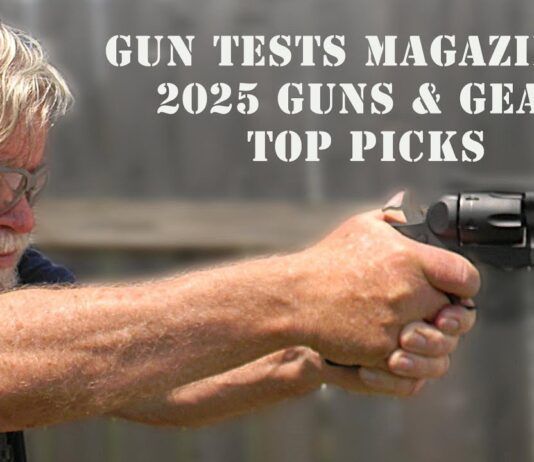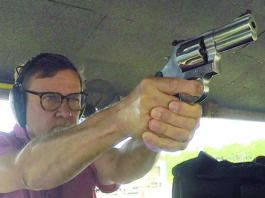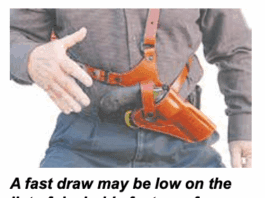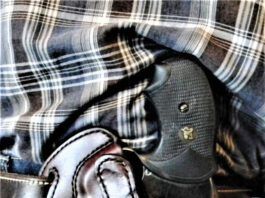DIY Gun Blueing from Birchwood Casey
Top Hunting and Shooting Equipment Brands for 2010
Videos on GunReports.com!
Gun News from Around the Web: Feb 21, 2011
Crimson Trace Announces Master Series Lasergrips for the 1911
Gun News from Around the Web: Week of Feb 6-12, 2011
Shootmyash Opens 2011 with a Bang, Targets Airsoft Market
Thoughts on Concealed Carry
For more years than I'd care to recall I've had a gun secluded on my person somewhere. No, I didn't always have a CCW permit. During all those years I've never had to present the gun to stop a fight, but many times along the way I was mighty glad I was armed.
Multi-Use Holsters: Can One Leather Choice Do Two Jobs?
Here at Gun Tests we do not often address intangibles. We measure performance in a logical manner. We test firearms, devices, and ammunition in a repeatable and verifiable manner. We do so in order to produce a level playing field for products. This is a credible standard for comparison. Just the same, sometimes a concept is worth a hard look. This month we are addressing the concept and execution of holsters that are designed to fill more than one mission. We have explored the concept and found that, at least in the case of some of the holsters tested, the concept is viable.
We wondered, is it possible to have a holster that fulfills several different jobs. Or would we find the truth of the adage, "jack of all trades—and master of none," and learn that a certain holster style is suited only to a single style of deployment? There have been numerous multi-function holsters advertised to fill more than one mission. We chose to cover six holsters that have been advertised as multiple-role holsters. These range from more-or-less standard holsters with extra belt loops to a holster with multi-directional belt loops.
But inquisitive GT readers (you know who you are) will challenge: Why compromise at all? Why not simply choose a single holster for each mission? Realistically, who wants to have to swap rigs to move from car to office to restaurant, especially for those of us living in a true four-season climate? If one holster can work inside the waistband (IWB) for concealment, as a strong-side belt scabbard offering real speed and comfort, and as a cross-draw holster for those who are seated or driving most of the day, that would indeed be a valuable piece of kit. Also, with quality custom leather and Kydex holsters approaching $100 dollars or more, it is important that we make a good choice.
Our test products were the Ted Blocker X 16, $97; Tauris Double Shift, $160; K&D Holsters' Thunderbird Defender, $95; Raven Concealment Systems Phantom, $90 (which includes an optional $20 loop kit); Simply Rugged Tribute, $95; (which includes $10 for IWB loops); and the Classic Old West Styles Four Way Holster, $38.
To start, we examined these units with an eye toward assessing the use of good materials, professional surface finish, and tight, durable stitching. How well the holsters function in the field is another matter, so we tested these holsters on the body extensively. Several team members wore a rig for at least a week each, then traded off holsters to various raters. We also drew handguns from them and shot targets at a range.
In particular, we focused on cant and rake during our field and shooting assessments. Cant is the angle of the holster away from the body. Rake is the angle of the muzzle. If the muzzle is pointed to the rear or spine of the holster, it's is a "rear rake" design. Almost all holsters are a rear rake design. A very few are a neutral cant, useful for the most part with compact handguns. The forward rake holster is most often seen as a competition holster for very tall shooters. A forward rake would expose the butt to printing on the garments and would be unsuitable in a concealed-carry holster.
At the end of the field and range work, we compiled the tester's pro-and-con comments during a roundtable discussion. To avoid a lackluster "jack of all trades, master of none" nomination, the holsters had to receive an A grade in one of their design missions and at least a B grade in the second. In other words, a strong-side holster that could be carried as an IWB needed an A grade as a strong side and a B grade as an IWB to pass.
HSS Introduces The Lady Pro Series safety vests
Auction Arms and GunReports.Com Form Gun News Alliance
(GunReports.com) -- Auction Arms, the official auction site of the NRA, and GunReports.Com have announced a letter of intent to establish the Auction Arms News Bureau, a weekly E-Letter that will deliver gun news, pricing trends and other information for the serious shooter.



























